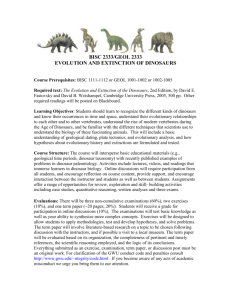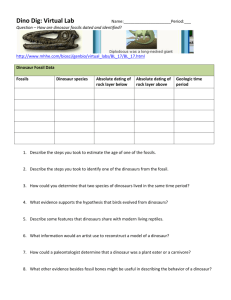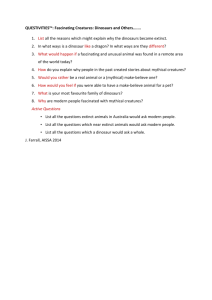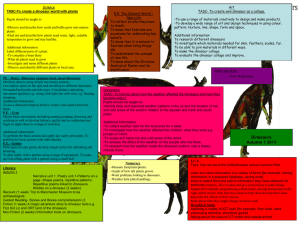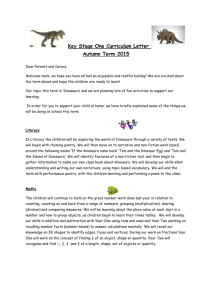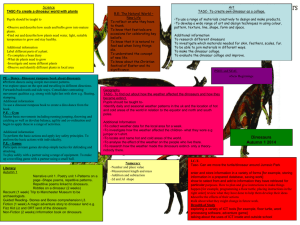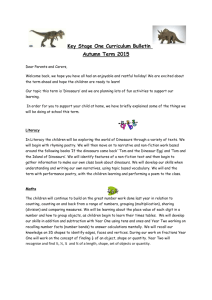Dinosaurs_Warm-VsCold
advertisement
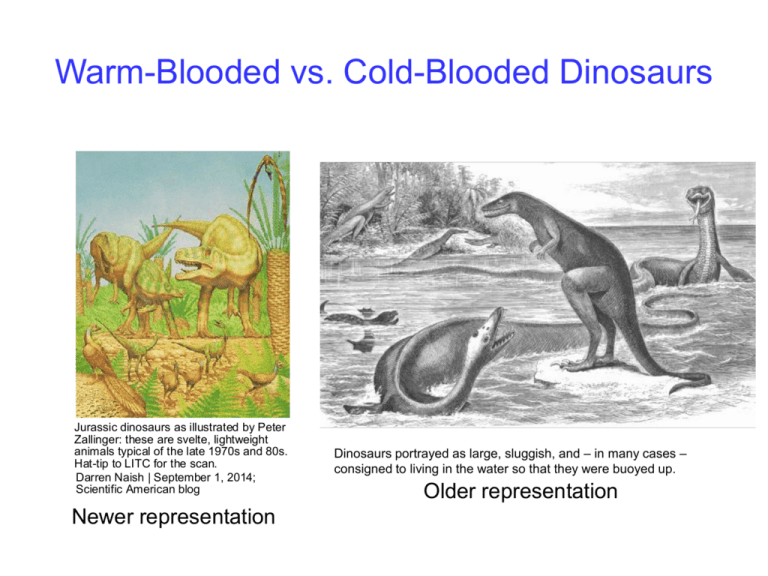
Warm-Blooded vs. Cold-Blooded Dinosaurs Jurassic dinosaurs as illustrated by Peter Zallinger: these are svelte, lightweight animals typical of the late 1970s and 80s. Hat-tip to LITC for the scan. Darren Naish | September 1, 2014; Scientific American blog Newer representation Dinosaurs portrayed as large, sluggish, and – in many cases – consigned to living in the water so that they were buoyed up. Older representation Early Discoveries and Studies of Dinosaurs • • • • Chinese reports 2000 years ago about what were probably dinosaur remains. Western reports of giants, ogres, dragons, etc. probably referred to dinosaur fossils. In 1676, a huge thigh bone was unearthed in England by a Reverend Plot; reported in the literature in 1763 by R. Brookes. 1787 – first dinosaur found and described in the U.S. by a physician. • • First dinosaur to be described scientifically (1824) was Megalosaurus. Described by Rev. William Buckland (1784-1856), well-known British geologist and paleontologist. • Gideon Mantell, physician and amateur British fossil-hunter who studied dinosaurs; he named the Iguanodon. • Sir Richard Owen (1804-1892) was a British comparative anatomist, who introduced the term dinosauria (“fearfully great lizard”). Owen noticed certain anatomical features that distinguished dinosaurs, e.g., columnlike legs that project directly down from body and 5 vertebrae fused to pelvic girdle. • [Mary Anning and the story of the “fossilists” at Lyme Regius, town on the English Channel] Gideon Mantell, MD Sir Richard Owen Mary Anning Rev. William Buckland The Fossilists Introduction to Dinosaurs and Their Biology Terrestrial reptiles (order Dinosauria) that lived from about 225 mya (late Triassic) to 66 mya (end Cretaceous). Dominant terrestrial animals in Jurassic and Cretaceous, although mammals coexisted with them over this time period. Size range: chicken-sized to huge herbivores called sauropods (largest terrestrial). Upright rather than sprawling legs. Earliest dinosaurs appear to have been predators: large, blade-like teeth; wide scissorlike jaws; did not chew, but rather swallowed food whole. Sauropod herbivores had mouths ideal for stripping leaves off of plants, but not for chewing; swallowed food whole. Some dinosaurs appear to have made use of gastroliths (swallowed stones) to aid in their digestion; helped to grind food in the gizzard (as birds have today). No dinosaur eggs larger than basketballs have been found; some small eggs found to contain embryos of larger species of dinosaurs. Dinosaurs, like mammals, had a fixed size beyond which they did not continue to grow (which is what modern lizards do, given sufficient food). Archosauria Dinosauria Saurischia Aves Phytosaurs Crocodilians Pterosaurs Ornithischian dinosaurs Birds Saurischian dinosaurs Dinosaur Classification feathers Ceratopsia horn faced Cerapoda Most recent common ancestor of crocodilians and birds Ornithopoda bird footed Pachycephalosaur thick headed Ornithischian bird hipped Stegosaur plated Thyreophora Dinosaurs Ankylosaur armor covered Sauropoda Saurischian lizard footed lizard hipped Theropoda beast like Comparative hip and joint posture (Wikipedia). Dinosaur Anatomy Changing Views of Dinosaur Lifestyles Mixed views early on concerning dinosaur lifestyle. 1850s reconstructions of dinosaurs in Crystal Palace. Huge, slow-moving, lizard-like, quadruped reptiles. However, Richard Owen had thought that heart and respiratory system of dinosaurs were akin to those of mammals. Dinosaurs remained of considerable paleontologic interest; their diversity was studied. They were marveled at for the apparent biological “success.” Then John Ostrom, a professor of paleontology at Yale, shook up the dinosaur community in the 1960s. He spent many years refuting the notion of dinosaurs as slow-moving, cold-blooded, and none too bright. Images from Wikipedia The 1897 painting of "Laelaps" (now Dryptosaurus) by Charles R. Knight (American artist noted for his influential paintings of prehistoric animals, incl. dinosaurs). Reconstruction of Megalosaurus from 1854, in Crystal Palace, London Ostrom’s Work on “Fleet-Footed” Dinosaurs 1964: Ostrom was finishing up a season of field work near Bridger, Montana. Spotted large, clawed dinosaur foot projecting from an outcrop. Of the three toes, two had normal claws, but the innermost toe had a sickle-like claw curved up and outward. Could slash a 180-degree arc. Called it Deinonychus (“terrible claw”). Spent next two field seasons removing fossil material from the site and three years of study back at Yale. Ostrom in 1969 declared that this specimen more clearly indicated the living behavior of dinosaurs. He wrote that Deinonychus “must have been a fleet-footed, highly predaceous, extremely agile, and very active animal, sensitive to many stimuli and quick in its responses.” Robert Bakker Ostrom imparted this information at the 1969 North American Paleontological meeting. Quite an audience response! Deinonychus in full sprint, as drawn by Robert Bakker ’67 — a student of Ostrom’s and a crusader for the view that dinosaurs were active, dynamic animals. The drawing appeared in Ostrom’s 1969 paper announcing the discovery of Deinonychus. Ostrom’s Work on “Bird-Like” Dinosaurs By 1970, Ostrom, regarded as the world’s leading authority on dinosaurs, was visiting Teylers Museum in Haarlem, the Netherlands. Viewed two matching limestone slabs collected in 1855 in Germany by paleontologist Herman von Meyer. Later, 1861, made famous by writing the first description of Archaeopteryx. Specimen in the museum, however, was labeled as an ordinary pterosaur (flying reptile). Ostrom first noted in the fossil a similarity to the bone and joint structure of Deinonychus – the same structure that enabled it to be a fast-moving, agile killer. He went to the window for better lighting. Saw impressions of feathers! It appeared to be an Archaeopteryx – what would be the first-found such sample. Only 3 other samples known. He revealed his suppositions to the curator. Amazingly, the museum allowed him to take the sample back to Yale for further study. The curator said, “You have made our museum famous.” Ostrom subsequently wrote about the similarities between Deinonychus and Archaeopteryx. Supported the idea that birds had evolved from dinosaurs. He acknowledged T.H. Huxley, “Darwin’s Bulldog,” who also had pointed out similarities between the reptile-like bird Archaeopteryx and bird-like reptiles, suggesting an evolutionary relation. Met much resistance for the next 3 decades, but eventually won the argument. The follow-up question became why were the birds the only dinosaurs to survive the K-T extinction? Robert Bakker’s Entrance on the Scene Was an undergrad at Yale and did some work with Ostrom. They apparently independently arrived at the notion of dinosaurs as high-energy, fast-moving animals. Bakker drew the sketch of Deinonychus (now famous) used in Ostrom’s 1969 paper. Whereas Ostrom was always very cautious about his statements (backed by years of work on the fossils), Bakker was an outspoken “evangelist” for dinosaurs. Bakker was convinced that dinosaurs were “superior” creatures and was especially intrigued by how they dominated mammals during their long period of co-existence. Ostrom had started a “dinosaur renaissance” in the 1970s and Bakker was very much a part of the media aspects of it. Bakker’s long 1975 paper in Scientific American lays out the basic approaches he took to defend his idea of dinosaurian superiority, especially that they were warm-blooded. Dinosaurs were “…better adapted to a wide range of environments and immensely more sophisticated in their bioenergetic machinery than had been thought.” (p. 58) Endothermic Ectothermic He maintained that dinosaurs are endothermic, but allowed that smaller species needed feathers to conserve heat. Bakker (1975) set the stage. Endothermic animals can biochemically tune body temperature to operate in a narrow range. Ectothermic reptiles and amphibians of Carboniferous and Permian periods were the first terrestrial vertebrates. Primitive. Endothermic mammal-like reptiles (therapsids) appeared in the Triassic, but did not dominate. Mammals remained small and rather inconsequential for the next 140 million years. Bakker’s ways of evaluating body metabolism from fossil evidence. 1. Bone histology 2. Latitudinal (climate) zones 3. Predator-prey relations BONE Reptiles have “low activity” pattern. Few blood vessels and Haversian canals. Growth rings or LAGs (Lines of Arrested Growth) seen, reflecting hibernation. LATITUDE (TEMPERATURE) Large reptiles cannot survive cold winters. (Small lizards can hibernate underground.) PREDATOR-PREY RATIOS The ratio reflects the metabolism of the predator regardless of size of animal (scaling). Energy needs of endothermic population are 10x more than that of ectotherms. In ectotherms, the P-P biomass ratio is high: 35-60%, like modern lizards and spiders. Comparative Bone Histology Bone microstructure of polar hypsilophodontid approaching skeletal maturity. Arrows point to LAGs (lines of arrested growth), as seen in hibernating animals. Mammalian bone, showing (Left) a single osteon (about 150 micrometers across) with its central Haversian canal (indicating blood vessel) and (Right) heavily osteonized bone. Bakker’s data from other sources: Armand Riqles, comparative anatomist from Paris, did detailed bone histology studies. Saw differences in bone of the early therapsids (mammal-like reptiles) – full of blood vessels and Haversian canals. If therapsids were endothermic, they would have ability to spread into colder regions, such as southern Africa and South America. Indeed, they did. The predator:prey ratios in those communities were 9-16%. Therapsids followed by thecodonts, which initially seem to have been ectothermic. Later, apparently became endothermic. Dinosaurs were descendents of early thecodonts; traced back to middle Triassic. Latitudinal evidence not strong. Bone histology stronger: high blood-vessel density, many Haversian canals. Predator:prey ratio data very strong: 1-3%. Bakker reflected that it was not unexpected that endothermy pre-dated enlarged brains; higher-level brain activity requires relatively constant temperature. Some small- to medium-sized dinosaurs had brains whose size relative to body size is the same or greater than that in some birds. Dinosaur body proportions resemble that of modern running mammals. Scapula, etc. Their extinction??? Refutations, Confirmations, Clarifications Morell’s 1996 article revealed holes in Bakker’s arguments. Harvard grad student Owerkowicz studied bones of size-matched lizards and mammals in paired tests of heavily exercised and fairly sedentary animals. The Haversian canal density was found to reflect the amount of movement/exercise. XX Nose size as an attribute of metabolism. John Ruben, physiologist at Oregon State University followed the story of turbinates in noses of mammals and birds – necessary to retain body heat and moisture. Even though turbinates (cartilage) do not preserve well, their presence demands greater volume in the nasal cavity. Dinosaur nasal volumes plot with those of lizards and crocodiles. XX Grady et al. (2014) “Evidence for mesothermy in dinosaurs”, Science, 344, 1268-1272. Cannot say that metabolism is either endothermic or ectothermic. Dinosaurs fall into the mesothermic group, as do tuna, lamnid sharks**, and leatherback turtles. Mesotherms control their body heat, but do not maintain the body at a constant temperature. There is a metabolic spectrum among animals. Grady and colleagues investigated in a more detailed way the relation between metabolism and growth rate. Then they used modern and fossil bones to determine growth rate (counting number of growth rings in fossil bone, measuring bone length to estimate body mass). Found that mammals that grew 10x faster than reptiles, showed metabolic rates 10x faster. Dinosaurs plotted midway between the values for endotherms and ectotherms. Possible advantage to the “middle road”: Move more quickly than a reptile, but require less food than a mammal of same size. Grady wants to extend this study to fossils from cold environments (Alaska, Antarctica); believes that cold temperatures will exaggerate differences between endotherms and ectotherms. **Lamnid sharks are a group of large, fast-swimming sharks with pointed snouts and huge teeth. They can weigh twice as much as other sharks of the same length (Wikipedia). From Grady, et al. (2014) Science. From Grady, et al. (2014) Science. From Grady, et al. (2014) Science. From Grady, et al. (2014) Science. Results of the Dinosaur Re-evaluations Connection between thermal control of body (e.g., ectotherm vs. endotherm) and: Evaluation of motions and speed of body movements Biomechanics, bone histology Rate of growth Warm-blooded vs. cold-blooded Relation between dinosaurs and birds evaluated Pelvic region Air sacs, gizzard Presence/absence of feathers Conclusions Dinosaurs are mesotherms Saurischia (not ornithischia) gave rise to birds Good References **Bakker R.T. (1975) Dinosaur renaissance: Scientific American, v. 232, issue 4 (April), pp. 58-78. Conniff, R. (2014) The man who saved the dinosaurs: Yale Alumni Magazine (digital edition), Jul-Aug 2014. Fellman, B. (2008) Extreme makeover: Yale Alumni Magazine, May-June 2008, pp. 40-47. **Grady, J.M., Enquist, B.R., Dettweiller-Robinson, E., Wright, N.A., and Smith, F.A. (2014) Evidence for mesothermy in dinosaurs: Science, v. 344, pp. 1268-1272. Kohler, M., Marin-Moratalla, N., Jordana, X., and Aanes, R. (2012) Seasonal bone growth and physiology: Nature, v. 487, pp. 358-361. **Morell, V. (1996) A cold, hard look at dinosaurs: Discovery Magazine (digital edition), December 1996. Padian, K., de Ricqles, and Horner, J.R. (2001) Dinosaurian growth rates and bird origins: Nature, v. 412, pp. 405-408. Seebacher, F. (2003) Dinosaur body temperatures: The occurrence of endothermy and ectothermy: Paleobiology, v. 29, pp. 105-122. ** References specifically cited in the slide show.

